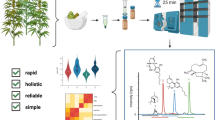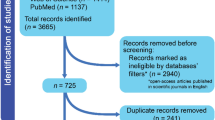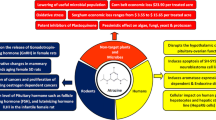Abstract
With the increase of improper use of pesticides in recent years, monitoring programs for pesticide residues have become commonplace around the world. In Brazil, sweet pepper has presented the highest percentage of irregular samples over 10 years of monitoring. The aim of this study was to optimize and validate a quick and effective method for the determination of 81 pesticides in sweet pepper using modified QuEChERS (quick, easy, cheap, effective, rugged, and safe) method and ultra high-performance liquid chromatography–tandem mass spectrometry (UHPLC-MS/MS). Experimental conditions of sample preparation were optimized by central composite design (CCD) in order to obtain an adequate extraction of the selected compounds. Recoveries from spiked samples at 10, 50, and 100 μg kg−1 ranged between 70 and 120 % with relative standard deviation (RSD) <20 %, except for thiophanate methyl that presented lower recoveries due degradation. Considering the occurrence of matrix effect, the quantification was performed using matrix-matched calibration. The experimental method limits of detection and quantification were 3 or 7.5 and 10 or 25 μg kg−1, respectively. In the analysis of 20 commercial samples of sweet pepper, residues of 14 pesticides were quantified in concentrations ranging from 10 to 294 μg kg−1, some higher than the MRL established by the Brazilian and European legislation. The proposed method combines the advantages of QuEChERS and UHPLC-MS/MS and proved to be suitable for the pesticide multiresidue determination in sweet pepper in routine laboratory analyses.




Similar content being viewed by others
References
AGROFIT (2014) Sistema de Agrotóxicos Fitossanitários. http://extranet.agricultura.gov.br/agrofit_cons/principal_agrofit_cons. Accessed 20 Apr 2014
Anastassiades M, Lehotay SJ, Stajnbaher D, Schenck FJ (2003) Fast and easy multiresidue method employing acetonitrile extraction/partitioning and “dispersive solid-phase extraction” for the determination of pesticide residues in produce. J AOAC Int 86:412–431
ANVISA (2014) Programa de Análise de Resíduos de Agrotóxicos em Alimentos. http://s.anvisa.gov.br/wps/s/r/cSbO. Accessed 20 Apr 2014
CEN Standard Method EN 15662:2009. Food of plant origin-determination of pesticide residues using GC-MS and/or LC-MS/MS following acetonitrile extraction/portioning and clean-up by dispersive SPE-QuECHERS method.
Dejaegher B, Heyden YV (2011) Experimental designs and their recent advances in set-up, data interpretation, and analytical applications. J Pharm Biomed Anal 56:141–158
EP/INCQS (2014) Ensaio de Proficiência para Determinação de Agrotóxicos em Hortifrutigranjeiros, 8ª rodada –Pimentão. http://www.incqs.fiocruz.br/images/stories/incqs/ensaio/2013/AGR_08_13_Relatorio_Final.pdf. Accessed 18 Apr 2014
FASOnline (2014) International Maximum Residue Level Database. http://www.mrldatabase.com/. Accessed 20 Apr 2014
Fenik J, Tankiewicz M, Biziuk M (2011) Properties and determination of pesticides in fruits and vegetables. Trends Anal Chem 30:814–826
Fernández-Alba AR (2005) Chromatographic-mass spectrometry food analysis for trace determination of pesticide residues. Elsevier, Amsterdam
Fernández-Alba AR, Tejedor A, Agüera A, Contreras M, Garrido J (2000) Determination of imidacloprid and benzimidazole residues in fruits and vegetables by liquid chromatography-mass spectrometry after ethyl acetate multiresidue extraction. J AOAC Int 83:748–755
Guillarme D, Ruta J, Rudaz S, Veuthey JL (2011) New trends in fast and high-resolution liquid chromatography: a critical comparison of existing approaches. Anal Biochem Chem 397:1069–1082
Hibbert DB (2012) Experimental design in chromatography: a tutorial review. J Chromatogr, B 910:2–13
Huerta B, Jakimskab A, Grosa M, Rodríguez-Mozaza S, Barceló D (2013) Analysis of multi-class pharmaceuticals in fish tissues by ultra-high-performance liquid chromatography tandem mass spectrometry. J Chromatogr A 1288:63–72
Jardim ANO, Caldas ED (2012) Brazilian monitoring programs for pesticide residues in food—results from 2001 to 2010. Food Control 25:607–616
Kruve A, Künnapas A, Herodes K, Leito I (2008) Matrix effects in pesticide multi-residue analysis by liquid chromatography-mass spectrometry. J Chromatogr A 1187:58–66
Lehotay SJ, Kok A, Hiemstra M, Van Bodegraven P (2005) Validation of a fast and easy method for the determination of residues from 229 pesticides in fruits and vegetables using gas and liquid chromatography and mass spectrometric detection. J AOAC Int 88:595–614
Malato O, Lozano A, Mezcua M, Agüera A, Fernandez-Alba AR (2011) Benefits and pitfalls of the application of screening methods for the analysis of pesticide residues in fruits and vegetables. J Chromatogr A 1218:7615–7626
MAPA (2013) Normative Instruction SDA nr. 18, from 25th June 2013. http://www.agricultura.gov.br/arq_editor/file/CRC/IN%2018%20%20Final.pdf. Accessed 28 Apr 2014
Núñez O, Gallart-Ayala H, Ferrer I, Moyano E, Galceran MT (2012) Strategies for the multi-residue analysis of 100 pesticides by liquid chromatography-triple quadrupole mass spectrometry. J Chromatogr A1249:164–180
Popov SV, Ovodova RG, Golovchenko VV, Popova GY, Viatyasev FV, Shashkov AS, Ovodov YS (2011) Chemical composition and anti-inflammatory activity of a pectic polysaccharide isolated from sweet pepper using a simulated gastric medium. Food Chem 124:309–315
Rêgo ER, Rêgo MM, Matos WF, Barbosa LA (2011) Morphological and chemical characterization of fruits of Capsicum spp. accessions. Hortic Bras 29:364–371
Reifschneider FJB, Henz GP, Ribeiro CSC (2009) Brazilian capsicums: early history and future prospects. Chron Horticult 49:19–21
Sinha SN, Rao MVV, Vasudev K (2012) Distribution of pesticides in different commonly used vegetables from Hyderabad, India. Food Res Int 45:161–169
Sousa FA, Costa AIG, Queiroz MELR, Teófilo RF, Pinho GP, Neves AA (2013) Influence of pH and matrix components in the chromatographic response of pesticides. Chromatographia 76:67–73
Zhan J, Zhong YY, Yu XJ, Peng JF, Chen S, Yin JY, Zhang JJ, Zhu Y (2013) Multi-class method for determination of veterinary drug residues and other contaminants in infant formula by ultra performance liquid chromatography-tandem mass spectrometry. Food Chem 138:827–834
Zhang K, Wong JW, Yang P, Tech K, DiBenedetto AL, Lee NS, Hayward DG, Makovi CM, Krynitsky AJ, Banerjee K, Jao L, Dasgupta S, Smoker MS, Simonds R, Schreiber A (2011) Multiresidue pesticide analysis of agricultural commodities using acetonitrile salt-out extraction, dispersive solid-phase sample clean-up, and high-performance liquid chromatography–tandem mass spectrometry. J Agric Food Chem 59:7636–7646
Acknowledgments
The authors are grateful to the Brazilian agencies support CNPq, CAPES, and FINEP for the financial support, and also to Professors Isabel C.S.F. Jardim (UNICAMP) and Liane Maldaner (UEM) for providing the fluorinated phase.
Conflict of Interest
Magali Kemmerich declares that she has no conflict of interest. Tiele M. Rizzetti declares that she has no conflict of interest. Manoel L. Martins declares that he has no conflict of interest. Osmar D. Prestes declares that he has no conflict of interest. Martha B. Adaime declares that she has no conflict of interest. Renato Zanella declares that he has no conflict of interest. This article does not contain any studies with human or animal subjects.
Author information
Authors and Affiliations
Corresponding author
Rights and permissions
About this article
Cite this article
Kemmerich, M., Rizzetti, T.M., Martins, M.L. et al. Optimization by Central Composite Design of a Modified QuEChERS Method for Extraction of Pesticide Multiresidue in Sweet Pepper and Analysis by Ultra-High-Performance Liquid Chromatography–Tandem Mass Spectrometry. Food Anal. Methods 8, 728–739 (2015). https://doi.org/10.1007/s12161-014-9951-2
Received:
Accepted:
Published:
Issue Date:
DOI: https://doi.org/10.1007/s12161-014-9951-2




